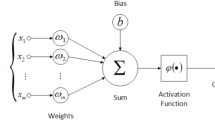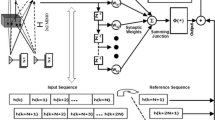Abstract
Signal degradation due to crosstalk-related issues has become increasingly important particularly in high-speed signal transmissions. Conventional analysis of crosstalk requires a full electromagnetic modeling of the signal transmission path along with a time-domain transient simulation which is computationally demanding. In this work, we apply a multilayer perceptron neural network for crosstalk prediction in coupled transmission lines. The well-trained neural networks can be used to predict the time-domain crosstalk directly, thereby replacing complex circuit simulations. Numerical results show a high degree of generalization of the neural networks, which are able to produce accurate results and can be trained to include effects such as reflections and input mismatches.




















Similar content being viewed by others
References
Fan J, Ye X, Kim J, Archambeault B, Orlandi A (2010) Signal integrity design for high-speed digital circuits: progress and directions. IEEE Trans Electromagn Compat 52(2):392–400
Deo M, Enabling next-generation platforms using Intel’s 3D system-in-package technology [White paper]. Retrieved from http://www.intel.com
Hill DA, Cavcey KH, Johnk RT (1994) Crosstalk between microstrip transmission lines. IEEE Trans Electromagn Compat 36(4):314–321
Rizvi M, LoVetri J (1996) Modeling and reduction of crosstalk on coupled microstrip line structures and multichip modules: an FDTD approach. Int J Microw Millim-Wave Comput Eng 6(1):58–68
Xiao FC, Liu WK, Kami Y (2001) Analysis of crosstalk between finite-length microstrip lines: FDTD approach and circuit-concept modeling. IEEE Trans Electromagn Compat 43(4):573–578
Sohn YS, Lee JC, Park HJ, Cho SI (2001) Empirical equations on electrical parameters of coupled microstrip lines for crosstalk estimation in printed circuit board. IEEE Trans Adv Packag 24(2):521–527
Lu T, Sun J, Wu K, Yang Z (2018) High-speed channel modeling with machine learning methods for signal integrity analysis. IEEE Trans Electromagn Compat 60(6):1957–1964
Das D, Lee CSG (2018) Cross-scene trajectory level intention inference using Gaussian process regression and naive registration. Department of Electrical and Computer Engineering Technical Reports. Paper 491. Purdue University
Dai F, Bao G, Su DL (2010) Crosstalk prediction in non-uniform cable bundles based on neural network. In: Proceedings of the 9th international symposium on antennas, propagation and EM theory. IEEE, Guangzhou, pp 1043–1046
Cannas B, Fanni A, Maradei F (2002) A neural network approach to predict the crosstalk in non-uniform multiconductor transmission lines. In: 2002 IEEE International Symposium on Circuits and Systems. IEEE, Phoenix, pp 573–576
Ilumoka AA (2001) Efficient and accurate crosstalk prediction via neural net-based topological decomposition of 3-D interconnect. IEEE Trans Adv Packag 24(3):268–276
Mbairi FD, Siebert WP, Hesselbom H (2008) High-frequency transmission lines crosstalk reduction using spacing rules. IEEE Trans Compon Packag Technol 31(3):601–610
Wu S, Fan J (2013) Modeling of crosstalk between two nonparallel striplines on adjacent layers. IEEE Trans Electromagn Compat 55(6):1302–1310
Zhang QJ, Gupta KC, Devabhaktuni VK (2003) Artificial neural networks for RF and microwave design-from theory to practice. IEEE Trans Microw Theory Tech 51(4):1339–1350
Rayas-Sanchez JE (2004) EM-based optimization of microwave circuits using artificial neural networks: the state-of-the-art. IEEE Trans Microw Theory Tech 52(1):420–435
Ozkaya U, Seyfi L (2018) A comparative study on parameters of leaf-shaped patch antenna using hybrid artificial intelligence network models. Neural Comput Appl 29(8):35–45
Ye F, Zhang Z, Chakrabarty K, Gu X (2013) Board-level functional fault diagnosis using artificial neural networks, support-vector machines, and weighted-majority voting. IEEE Trans Comput Des Integr Circuits Syst 32(5):723–736
Sheikhan M, Sha’bani AA (2013) PSO-optimized modular neural network trained by OWO-HWO algorithm for fault location in analog circuits. Neural Comput Appl 23(2):519–530
Beyene WT (2007) Application of artificial neural networks to statistical analysis and nonlinear modeling of high-speed interconnect systems. IEEE Trans Comput Des Integr Circuits Syst 26(1):166–176
Hsu KT, Guo WD, Shiue GH, Lin CM, Huang TW, Wu RB (2008) Design of reflectionless vias using neural network-based approach. IEEE Trans Adv Packag 31(1):211–218
Kim H, Sui C, Cai K, Sen B, Fan J (2017) Fast and precise high-speed channel modeling and optimization technique based on machine learning. IEEE Trans Electromagn Compat 60(6):2049–2052
Raja MA, Mehmood A, Niazi SA, Shah SM (2018) Computational intelligence methodology for the analysis of RC circuit modelled with nonlinear differential order system. Neural Comput Appl 30(6):1905–1924
Hornik K, Stinchcombe M, White H (1989) Multilayer feedforward networks are universal approximators. Neural Netw 2(5):359–366
Hornik K (1991) Approximation capabilities of multilayer feedforward networks. Neural Netw 4(2):251–257
Hagan MT, Demuth HB, Beale MH, Jesús OD (2014) Neural network design. Martin Hagan
Setiono R, Hui L (1995) Use of a quasi-Newton method in a feedforward neural network construction algorithm. IEEE Trans Neural Netw 6(1):273–277
Hagan MT, Menhaj MB (1994) Training feedforward networks with the Marquardt algorithm. IEEE Trans Neural Netw 5(6):989–993
Nguyen T, Schutt-Aine JE (2018) A pseudo-supervised machine learning approach to broadband LTI macro-modeling. In: 2018 IEEE international symposium on electromagnetic compatibility and 2018 IEEE Asia-Pacific symposium on electromagnetic compatibility. IEEE, Singapore, pp 1018–1021
Nguyen T, Lu T, Sun J, Le Q, We K, Schut-Aine J (2018) Transient simulation for high-speed channels with recurrent neural network. In: IEEE 27th conference on electrical performance of electronic packaging and systems. IEEE, San Jose, pp 303–305
Acknowledgements
This work is supported by Universiti Sains Malaysia under the Research University (RUI) Grant (1001/PELECT/8014011).
Author information
Authors and Affiliations
Corresponding author
Ethics declarations
Conflict of interest
The authors declare that they have no conflict of interest.
Additional information
Publisher's Note
Springer Nature remains neutral with regard to jurisdictional claims in published maps and institutional affiliations.
Rights and permissions
About this article
Cite this article
Ooi, K.S., Kong, C.L., Goay, C.H. et al. Crosstalk modeling in high-speed transmission lines by multilayer perceptron neural networks. Neural Comput & Applic 32, 7311–7320 (2020). https://doi.org/10.1007/s00521-019-04252-3
Received:
Accepted:
Published:
Issue Date:
DOI: https://doi.org/10.1007/s00521-019-04252-3




